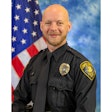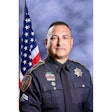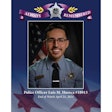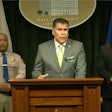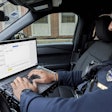 Illustration: LaMar Norman
Illustration: LaMar Norman
Late fall in Edina, Minn., can make mid-winter elsewhere seem mild by comparison. Nov. 16, 2000, was such a day. Snow had blanketed the city overnight, leaving an icy sheen on its streets and a chill in the air that cut to the bone.
By ten o'clock that morning, Edina Police Officers Mike Blood and Shelby Lane were relying on parkas and hot coffee to stave off the cold when they heard a call go out for a bank robbery in progress. For Edina's finest, things were about to warm up considerably.
Crimson Snow
Less than a half mile separated the officers from the FirStar Bank at the corner of 69th Street and France Avenue. Officer Blood pulled into the bank's parking lot from the south and Lane approached the main entrance from the bank's northeast side; the two units effectively achieved a 360-degree coverage of the bank's perimeter.
Inside the FirStar Bank, the robber was wrapping up business. For two years, David Lincoln White had supported himself by hitting banks. The 30-year-old Cincinnati police academy dropout had his routine down to a science, doing the requisite recon, and never overstaying his welcome in one place.
His script—a series of copious notes he kept on how to carry out successful robberies—had served him well. But today he deviated from it and helped himself to the tills a little longer. His lingering was such that by the time he did leave, the first thing he saw upon exiting the bank was Officer Blood's patrol unit pulling into the driveway—right between White and his getaway vehicle.
White raised his Ruger Mini-14 and opened fire. Bullets shattered the windshield of Blood's patrol vehicle and sheared off the top of his belt radio.
Blood dove out the driver's door in hopes of getting out of the kill zone. But White had other ideas as he trained the Ruger on the officer. Two more blasts rang out and Blood went down hard in the snow, the bones in his lower right leg pulverized. White approached the fallen officer and calmly pumped four more rounds into his back.
By the time White darted for his Ford Explorer, Shelby Lane had prudently taken cover in a snow bank. She had followed White's path out of the bank as communicated by the bank's vice president-who himself had been following White and reporting on his progress to Edina dispatch via telephone-when she heard gunfire.
Once she was sure that she wasn't being targeted, Lane returned to her squad and drove around to a connecting driveway between FirStar and another commercial bank. Lane saw Blood's squad car. But Blood was nowhere in sight.
A trail of blood led to her fellow officer's bloody body. Lane rendered first aid and radioed for paramedics. She also silently prayed that Blood's size might work to his advantage when it came to his coming out of this nightmare alive.
Shattered Windows
The sight of White's Explorer turning northbound onto Valley View Road caught Officer Billy Moyer's eyes, but it was the driver's failure to acknowledge his lights and siren that made Moyer fixate on the vehicle. No suspect vehicle description had yet been broadcast, but given the time, proximity, and limited prospects in the area, Moyer felt more than a little sure that the Explorer was something deserving of his attentions. Moyer made a U-Turn and prepped himself for what he thought would be the beginning of a pursuit.
Moyer's intuitions proved right on everything save for one thing: any immediate intent on the driver's part to flee. Moyer hadn't been behind the Explorer for more than a quarter mile before it suddenly skidded to a stop and its driver's side door opened.[PAGEBREAK]
A black male in a dark blue jumpsuit leaped out of the Explorer and into the middle of the road where he raised a rifle and aimed directly at Moyer. Rounds tore into Moyer's passenger compartment.
Moyer drew his Smith & Wesson 4013 TSW pistol and opened his car door to return fire. He'd just squeezed off a shot when a .223 round shattered his driver's spotlight, sending shards of glass into his face. Another went through his door and grazed the top of his forearm as still others riddled his car.
Then as suddenly as he'd initiated his assault White abandoned it. He got back into the Explorer as its rear windows exploded under Moyer's fire and sped off northbound.
Moyer reloaded his pistol before getting back into his squad to continue the pursuit. But his car was dead-a bullet had disabled its electronics system. Putting out what he could over the radio, the marooned Moyer ran back to the bank to do what he could to assist Blood.
The Crash
Never before had Sgt. Scott Kuyper been so aware of his code three response. Driving through the ice-slickened streets, he continually reminded himself that if there was ever a time that he didn't want to crash it was getting to this call.
With Officer Jim Rygg tailing, Kuyper's Chevy Tahoe headed southbound on Valley View Road. That's when he spotted an Explorer in the opposite direction. As the Explorer made a left turn in front of him without signaling, Kuyper noticed its back window was blown out.
Kuyper immediately pulled in behind the vehicle and initiated a pursuit. As he did, he could see its driver reaching into the back of his vehicle. The absence of pedestrians or oncoming traffic allowed Kuyper to drive on the wrong side of the road and force the suspect to take an extreme measure if he was going to shoot at him.
Near Highway 100, White slowed down as though intent on entering the highway. But finding no onramp, he picked up speed as he continued westbound.
They approached a T-intersection at Ridgeview Drive. Kuyper realized that the Explorer was going too fast to clear the intersection safely. Seconds later, the right side of the Explorer slammed into the far side curb, causing the vehicle to slide into the roadway and ripping the right rear tire off its rim. The Explorer ended up at a 90-degree angle across the road, his passenger side facing Kuyper and Rygg.
Jim Rygg was still calling out the pursuit behind him. And Kuyper had gone into a skid. By the time his Tahoe came to a stop atop the ice, his right rear bumper was only 45 feet from White's Explorer—much closer than Kuyper wanted to be when dealing with a suspect armed with a scoped rifle.
Crossfire
But it wasn't a rifle that Kuyper saw when the Explorer's driver stepped out-it was a 9mm Taurus. White's anxiety to get the drop on Kuyper was such that he discharged a round into his driver's side door. The impact of the 9mm Taurus created a double-feed that jammed the weapon. It would prove a costly mistake.
White tossed the disabled Taurus on the Explorer's front seat and again grabbed the Ruger.
Kuyper sprinted around to the right rear of his squad car. Stealing a quick glance down the road and finding no oncoming traffic, he drew his pistol.
Point shooting at 45 feet was not something that Kuyper had ever practiced before, but the need to get the suspect on the defensive was pressing. Knowing that he couldn't penetrate the doors and sheet metal, Kuyper fired seven rounds in rapid succession, blowing out White's passenger side window.[PAGEBREAK]
Kuyper's tactic paid off: White ducked down as Jim Rygg—situated to Kuyper's immediate right—fired three rounds from his location, striking White's right front fender. The bank robber was caught in a crossfire.
White took a kneeling position and Kuyper could see the barrel of the Ruger angle upward as the man tried to reload. The top part of White's head came into view so that Kuyper could see from the bottom of his earlobe to the top of his head. It was his opportunity and Kuyper knew it. He took a breath, got a sighted picture with his pistol, and squeezed off two rounds.
A Federal 165-grain hollow point round struck White in the top of the head. As White went down, the rifle barrel of his Ruger spun around so that, from the officers' perspectives, it looked as though White had proned out to engage them again from under the vehicle. As Kuyper jumped onto the rear bumper of his Tahoe, Rygg went up onto the curb on the right side of his squad car.
Between the Explorer's naturally high profile and its curbside canting, Kuyper could see beneath the vehicle to where blood was pooling in the snow beyond it.
Later, Kuyper would wish that he'd waited for more officers to show up before making an approach. But pumped with adrenaline, his compulsion was to make sure then and there that White was down and out of the fight. He finished reloading then went around to the back of the Ford Explorer while Rygg circled around to the front.
More Aggressive
Kuyper says his only goal during the shootout was to prevent White from wounding any more of his officers. "Radio communications was telling me that every time he engaged one of my officers he was shooting them up," Kuyper recalls. "That told me that when I ran into him I had to be more aggressive than he was. And I was."
Kuyper's aggressiveness was tempered with maturity. He knew full well the inherent risks when he decided to engage White, but felt comfortable in his abilities-abilities that were honed through years of range practice. Still, he learned some lessons that day, lessons that he has since seen incorporated into his department's training.
"Our training had always emphasized the need for officers to move and use cover. But by no means were there commensurate attentions paid to hostage targets or partial target presentation—someone peeking around a car. We've since increased those types of scenarios within our firearms training curriculum," Kuyper says.
Kuyper openly wonders what kind of mindset some officers hit the streets with given some of the comments he has heard.
"Some officers have questioned the need to shoot the suspect when he wasn't actively shooting at me, but ducking down and reloading. Hey, the fight's not over. He hasn't dropped the weapon or surrendered. And I'm not going to give him time to reload and time to get back into battery and start shooting. You need to end it," Kuyper explains.
Ending it can mean relying on less anticipated variables.
"At six feet, my height came into play," Kuyper reflects. "Had he engaged an officer such as Shelby Lane, she would not have been able to get the sight picture with which to shoot him in the head like that."
Kuyper's Tahoe was stocked with a 4013 TSW pistol, a 12-gauge Remington 870 shotgun, a Colt M16 full-auto rifle, as well as his own Ruger carbine rifle. But Kuyper chose to engage the robber with his pistol. He has no regrets in forgoing a more powerful weapon, believing that retrieving such a weapon might have cost him his life.
Kuyper's experience with firearms extends back to his days of shooting competition pistol as an explorer scout, and six years of experience as a firearms instructor at the time of the incident. A 14-year stint with SWAT didn't hurt, either. Next to lingering in the bank, White's decision to engage the sergeant in a firefight was about the biggest mistake he made that day.
And given White's history, it is a curious mistake for him to have made. He was obsessive in keeping himself in excellent physical condition and as conscientious in keeping notes on his diet and dating history as he was in how to do recon and takeovers. That attention to detail had allowed him to conduct at least 14 bloodless bank robberies from April 1998 to the day he rolled into Edina-a period that saw his cumulative haul total $253,900.
Officer Blood survived his grievous injuries and received a medical retirement. Moyer recovered almost immediately from his wounds.
Kuyper has received numerous decorations for his actions including his department's Award of Valor, the Minnesota Chiefs of Police Association Award of Honor, and the National Association of Police Organizations Top Cop Award. He continues to serve the citizens of Edina.
What Would You Do?
Put yourself in the shoes of the Edina, Minn., patrol officers who faced desperate, heavily armed bank robber David Lincoln White and ask yourself the following questions:
- Shards of the splintered headlamp could have blinded Officer Billy Moyer. If you wear prescription glasses, are your frames bullet-resistant? Have you considered ballistic-resistant eyewear?
- Psychologically prepping oneself for a "fight or flight response" is not only natural but recommended. Have there ever been times where you were psychologically committed to one action only to find yourself having to address an entirely different type of problem? How flexible do you consider yourself to be in such situations?
- Do you feel that your range training adequately addresses the prospect of engaging hostage-holding suspects or targets that are only partially targetable? Is your agency responsive to not only identifying problems with prior officer-involved-shooting incidents, but also incorporating solutions in its training?
- Even a veteran officer such as Sgt. Scott Kuyper found it difficult to rein himself in when it came to closing the gap between himself and the suspect when verifying the man's condition. Do you feel you're always in control of your emotions and your actions? How do you prepare yourself for such situations?










